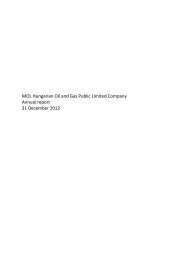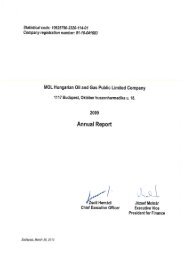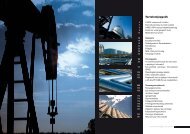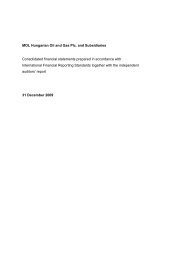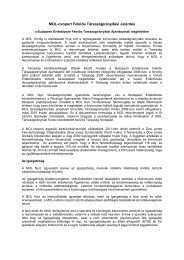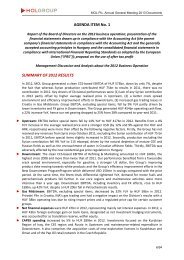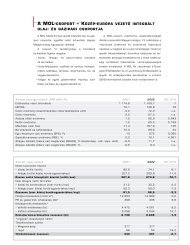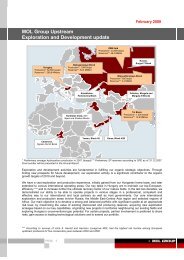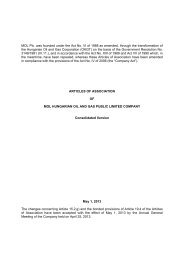MOL GROUP Annual Report
MOL GROUP Annual Report
MOL GROUP Annual Report
- No tags were found...
You also want an ePaper? Increase the reach of your titles
YUMPU automatically turns print PDFs into web optimized ePapers that Google loves.
Putting into productionAccomplishment of surface and underground facilities necessary for the production of hydrocarbon reserves.PyrolysisThermal cracking of hydrocarbons at high (usually above 650°C) temperature and low (few bars) pressure, which is the basicprocess in operation of olefin plants. Process is conducted in the presence of steam in order to minimize coke-formation.Pyro-naphthaMixture of valuable by-products with significant aromatic content, having boiling points within the range of naphtha, arisingbesides main products (ethylene and propylene) in the course of pyrolysis of petrochemical feedstocks (naphtha, chemical gasoiland other light hydrocarbons) in olefin plants. Can be converted to basic aromatics (benzene, toluene, xylenes, etc.) by furtherprocessing, while after appropriate hydrogenation it can also be used as high-quality, high-octane mogas blending component.Refinery marginDifference between product’s international quoted price and the actual crude oil price. Or: The unit profitability of a(theoretical or actual) refinery, which is determined by crude oil product, as well as unit refining costs.Refinery complexityRefinery complexity demonstrates, what white product yield can be achieved from 1 barrel of crude oil. The more complexthe refinery, the higher is the white product yield from the same quality crude oil ie. the less fuel oil it produces. One of thebest measure for complexity is Nelson index, which calculates complexity from the existence of different refinery plants andfrom the the ratio of their capacity to distillation capacity.Refining coverTotal refining capacity divided by total volumes of product soldResidue upgradingTo transform residues (heavy fuel oil) into more valuable white products.Russian export blend(API degree: 32.5, sulphur content: 1.25%) Mix of Russian crude oils whose quoted price is considered as a benchmark in theinternational crude oil markets.SAPPOSlovak Association of Petroleum Industry and TradeSteam cracker (olefin plant)Technology for production of key basic petrochemical products (olefins: ethylene, propylene, and aromatics: benzene, toluene,xylenes), on the basis of thermal decomposition (cracking) and dehydrogenation of petrochemical feedstocks (naphtha andchemical gasoil) produced by the refineries or lighter saturated hydrocarbons (ethane, propane, butane) in the presence of steam.Main products of the process (ethylene, propylene) are raw-materials of polyethylene and polypropylene production, while theby-products can widely be used in organic chemical industry, plastics and rubber production or as gasoline blending components.SCM (Supply Chain Management)Supply Chain Management coordinates the procurement of crude oil, other refinery feedstock and products, as well asrefining, logistics related to procurement or sales, and the wholesale of crude oil products. It targets to maximise <strong>MOL</strong> Groupprofit with optimising through the whole value chain.SPE based reserve valuationMethod used by the Society of Petroleum EngineersSpot contract/salesShort term sales, usually in a contract for one delivery.Strategic gas storageThe mobile natural gas reserve and the relevant peak withdrawal capacity aiming at implementing the Law XXVI. of 2006on strategic storage of natural gas. This reserve and capacity can be exclusively used for ensuring the security of natural gassupply in case of supply crisis , under the terms and conditions published in the relevant minister’s decree and such reserveshall be replenished.Thermal Power PlantA thermal power station is a power plant in which the prime mover is steam driven. Water is heated, turns into steam andspins a steam turbine which drives an electrical generator (regional average net electric efficiency of existing thermal powerplants is approximately 35%).Term contract/salesLong term contract, usually for one year or longer termToe (tonne of crude oil equivalent)Mass equivalent received from the heating value of gas following conversion to crude oil on the basis of heat unit. As a rule,1,200 Nm3 gas is equivalent to 1 toe.TransitGas transmission through pipeline, which crosses the border of one member of the European Economic Area and its startingor end-point is outside the European Economic Area.Transmission pipelineThis pipeline, including its accessories and fittings, is used for transmitting natural gas, and its starting or kick-off points arethe national border of the country, inlet points of gas production facilities, inlet and outlet points of underground gas storagefacilities, and the end or terminal points are the national border of the country, outlet points of gas transfer stations (citygates), inlet and outlet points of underground gas storage facilities.Ural BlendRussian, export quality crude oil. Heavy and sour (with high sulphur content) crude oil, therefore the price of Ural Blend islower than that of light Brent crude oil, which has low sulphur content.Financial TermsADRAmerican Depository Receipt, depository certificates issued by a foreign depository on the issuers shares, which aredeposited with a Hungarian custodian.CAPEXCapital ExpendituresCash Flow at Risk (CF@R)Methodology to measure the risks of the <strong>MOL</strong> Group. It takes into account the exposures to external factors (product price,rate of interest) of the different businesses within the <strong>MOL</strong> Group portfolio, as well as the volatilities and correlation betweenthose factors.EBITDA (Earnings before interest, tax, depreciation and amortisation)Operating profit plus depreciation and amortisationEBITDA marginRatio of EBITDA divided by net sales revenuesEPSEarnings per Share is based on the profit attributable to ordinary shareholders using the weighted average number of sharesoutstanding during the year after deduction of the average number of treasury shares held over the period.Financial CovenantIt is the rate calculated from specific terms of P&L, Balance Sheet and Cash-Flow. (Eg.: Net Debt per EBITDA, EBITDA perTotal Interest Expense) Financial Covenants are primarily applied in loan facility agreements to limit lenders’ credit risk.Glossary248 <strong>MOL</strong> Group annual report 2010 249



